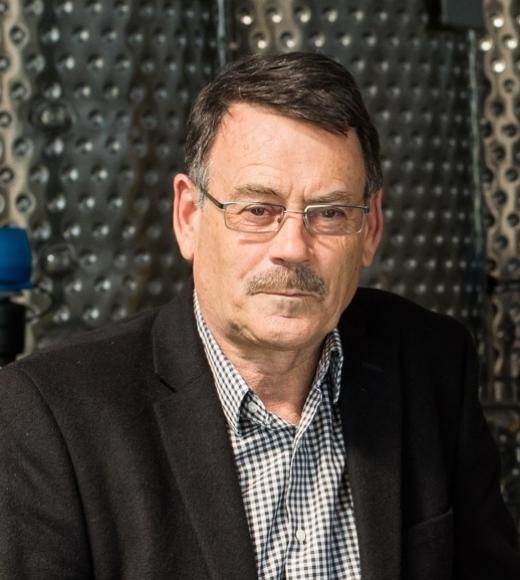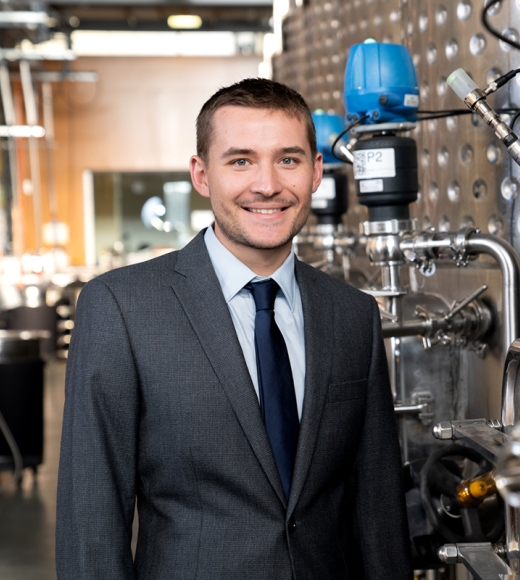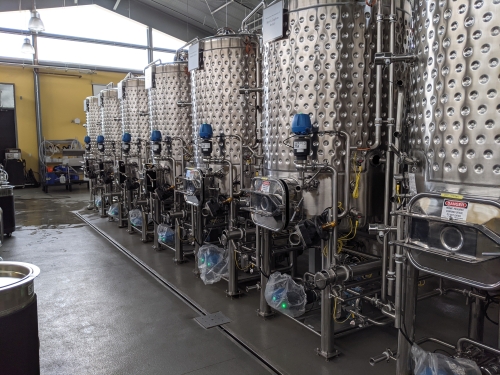
UC Davis Team Takes Next Big Step in Wine Research
For the first time on a commercial scale, researchers from UC Davis have controlled the redox potential during a wine fermentation, an important step in making winemaking more efficient and reproducible and paving the way for a new generation of experiments in viticulture, microbiology and fermentation.
Redox potential is a property of a solution, such as fermenting grape juice, that measures the ability of different chemical species to react with each other. It’s a complex and largely forgotten variable in wine fermentations, but it plays a role in determining the growth and survival of yeast (and bacteria) and the byproducts that are formed.

“It’s a missing variable about the environment that the organisms are going to operate in,” said Chemical Engineering (CHE) and Viticulture and Enology Distinguished Professor Emeritus Roger Boulton, who helped lead the study. “These organisms are going to change their metabolism, express different genes and behave a little differently because they have to adapt to a different condition—just like if it grew at a different temperature or a different pH.”
Redox potential relies on the combination of a number of factors: the concentration of tartaric and malic acids in grape juice, pH, glutathione — a reduction agent present in grapes but also produced by yeast — and the presence of trace metal ions that may come from the vineyard and their resulting complexes. Changing any one of these factors can significantly affect the redox potential, and this means that mixtures that have the same pH and temperature may have quite different redox potentials.
“If I took 10 Chardonnay juices and I measured their redox potential, they’d be all slightly different,” said Boulton. “And if I followed them during fermentation, the potential would decrease at different rates and extents because they’ve all got different combinations of glutathione, copper and iron in them. Most people try to use the potential as a measure of the concentration of one component such as oxygen, but it is a mixture property, not an indicator of any single component.”
A Better Fermentation
In wine fermentations, the redox potential moves in a U-shape curve over time. It starts high, decreases rapidly to below zero, and then rebounds slowly as the fermentation finishes. When the redox potential becomes too low, the yeast responds by producing and releasing byproducts to change it. This can slow the fermentation rate or introduce unwanted byproducts into the wine.

To counter this, Electrical and Computer Engineering (ECE) Ph.D. student James Nelson developed a programmable logic controller that constantly measures and controls the redox potential during fermentation. If the potential drops below a certain threshold, it opens a valve to let a small amount of air into the fermentation tank. The oxygen in the air is activated to form hydrogen peroxide, which increases the potential for a short period of time. The system keeps this up throughout the course of the fermentation to keep the potential constant.
The team’s studies showed that this helps yeast more thoroughly convert sugar to alcohol, which could make the process more efficient and reliable and reduces the risk of sluggish or stuck fermentations and microbial spoilage that can come with them.
“That has big implications for large-scale wine production, where you don’t want to be occupying a fermenter for another week just because the fermentation is tailing,” said Boulton.
They also theorize that it could decrease or even eliminate the production of hydrogen sulfide during fermentation. Hydrogen sulfide gives wine a rotten egg smell and is one of the industry’s most common production faults. Winemakers deal with it using a treatment process that is less than perfect, but this can be costly in terms of time and labor, so finding the source of production and changing the conditions that lead to its formation are crucial.
“If you prevent hydrogen sulfide from being formed, then you also prevent all these extra treatment steps,” said Nelson. “But if you don’t have the ability to measure and control redox potential, you can’t really do any reproducible research experiments.”
A New Age of Research
Until recently, redox potential sensors were so unreliable that researchers just gave up trying to measure it. This means despite the wealth of literature, few experiments are reproducible because they didn’t account for the variable, even though they knew it existed. Now that the technology has caught up and the team’s method has been demonstrated on a 10,000-liter commercial scale, Boulton says it’s time to go back and answer some old questions, as well as new ones.

“I have an incredible respect for the people who went before us, who thought of these things, but couldn’t do the controlled experiments,” he said. “James’ ability to hook up sensors, take signals, read them, store them, send them up to the cloud and bring them back onto your phone and quickly get data would take us ages to do on older computers, and the original thinking was at a time before computers.”
Nelson says there are a lot of researchers who don’t know about yeast metabolism, and their breakthrough could help answer questions about how they grow and age and which solution conditions they find most favorable. Boulton thinks that once the idea catches on, controlled redox potential could have an impact beyond wine and as an important part of all fermentations, from fuel alcohol to pharmaceuticals, yogurt, and all food fermentation.
“All we’re trying to do is build the tools to do the better experiments and to have this precision adopted into commercial fermentations.”
The Stone Unturned
Boulton credits the interdisciplinary and collegial environment of UC Davis for making the study possible. He says redox potential is a unique research area that requires expertise in chemistry, chemical engineering, electrical engineering and microbiology.
“It’s the road less traveled, and it’s the stone not turned and it’s this opportunity that comes from a combination of all of those fields,” he said.
This interdisciplinary research is made possible in part due to the Rodgers University Fellowship in Electrical and Computer Engineering, which funds ECE graduate students like Nelson to work in the Teaching and Research Winery and with the Department of Viticulture and Enology faculty. The research also benefited from collaboration with industry partner Robert Coleman at Treasury Wine Estates, who provided the grapes and commercial scale fermenter used in the study.
The team — Nelson, Boulton, Coleman, ECE Distinguished Professor André Knoesen, CHE Associate Professor Ron Runnebaum and UC Davis Head Winemaker Leticia Chacón-Rodríguez — published their results in the December 2022 issue of Fermentation.




